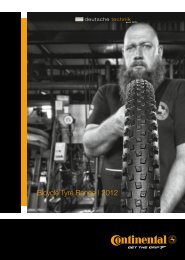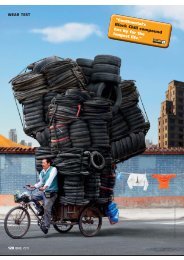2013 Tyre Brochure - Continental
2013 Tyre Brochure - Continental
2013 Tyre Brochure - Continental
You also want an ePaper? Increase the reach of your titles
YUMPU automatically turns print PDFs into web optimized ePapers that Google loves.
Deutsche Technik in detail<br />
77<br />
TWI – The wear indicator<br />
The wear rate and condition of any ‘treaded’ tyre like an MTB<br />
or touring model can be easily recognised by the obvious<br />
visual signs of wear to the tread lugs. Smooth or slick road<br />
tyres however do not offer any indication for their timely<br />
replacement. That is why <strong>Continental</strong> introduced wear<br />
indicators for smooth racing tyres back in 2004 on the Grand<br />
Prix 4000. The TWIs (Tread Wear Indicators) are on practically<br />
every <strong>Continental</strong> racing tyre these days. If the two small,<br />
circular depressions can no longer be seen in the middle of<br />
the tread, it is time for a replacement. This is an important<br />
aspect for rider safety as a worn tyres riding characteristics<br />
are no longer adequate. The wear indicators have also found<br />
their way into City trekking and e-bike<br />
tyres. The Top CONTACT II has a small<br />
crosspiece in the base of the tread<br />
groove which should show a<br />
minimum profile depth of at least<br />
1.6 mm. You can recognise<br />
<strong>Continental</strong> bicycle tyres with<br />
TWIs by the corresponding<br />
marking on the sidewall.<br />
TirePositioningSystem ®<br />
With the TirePositioningSystem, the last little bit of what is<br />
currently technically possible has been exploited.<br />
Motorcyclists have known for a long time: Different<br />
demands are made on a front tyre than on its rear<br />
counterpart. The narrower front tyre provides reduced wind<br />
resistance and better handling. An adhesion-optimised<br />
tread mixture supplies the necessary grip especially for wet<br />
cornering. The wide rear tyre offers better traction thanks to<br />
a larger contact area and at the same time more comfort.<br />
Thanks to the fast rolling, optimised tread mixture and the<br />
larger contact area on the rear tyre, wear is reduced. The<br />
result is a pioneering front<br />
22 mm 24 mm tyre and rear tyre system for<br />
road racing; to be found in<br />
our GP Attack and Force<br />
combination. – New for<br />
<strong>2013</strong>: The first tubulars<br />
featuring the TPS system!<br />
Dynamo – Preparation<br />
<strong>Tyre</strong>s which have the Dynamo symbol have a special profiling<br />
in the side wall and are especially suitable for use with<br />
rotating dynamos. The Dynamo thus runs quieter and does<br />
not slip in wet conditions. Depending on the tyre model, the<br />
dynamo knurl design can vary.<br />
Suitable<br />
for Dynamo<br />
Casing construction & TPI –<br />
the makeup of the basic tyre structure.<br />
The carcass is the basic structure for all tyres. The<br />
construction of the carcass, the material and the thickness of<br />
the thread depends on the demands that are placed on the<br />
tyre. <strong>Continental</strong> always works with high-quality carcasses<br />
made from nylon strings that are first woven and then<br />
rubberised. Nylon can be easily combined with rubber and is<br />
durable in all types of weather. The thickness of the thread<br />
gives the tyre its specific attributes. Thread thickness is<br />
recorded in TPI (threads per inch) and describes the number of<br />
threads per 2.54 cm (1 inch). Fabrics used have 22 TPI, 28 TPI,<br />
60 TPI and 110 TPI. Very fine material makes the tyre smoother<br />
and protects the carcass from punctures. Coarse fabric is<br />
more cut-resistant and makes the tyre more robust. The choice<br />
of fabric correlates to the purpose of use. The standard is a<br />
three-ply basic carcass. Additional breakers can be put under<br />
the tread in order to reinforce the tyre even more and to<br />
increase puncture protection. There are different types of<br />
breaker builds and materials for different uses whether they<br />
are highly elastic specialty rubber, such as our Plus brand or<br />
fabric breakers, such as PolyX and Vectran in our race tyres.<br />
You can see how the tyre is constructed in the tyre<br />
specification. Points listed are the number of layers, the sum<br />
of the TPI and the type of puncture protection. 3/180 +<br />
Vectran is equivalent to three layers of a 60 TPI fabric with<br />
an additional Vectran Breaker.<br />
2,54 cm<br />
110 threads per 2.54 centimeters of a single layer of fabric<br />
Tread<br />
Puncture-proof plies<br />
Notes – Air pressure.<br />
Air pressure directly influences the handling, durability and<br />
the rolling resistance of a bicycle. Only with the right<br />
operational pressure can a tyre operate to its full potential.<br />
In addition to tyre volumes and cyclist or system weight, the<br />
purpose plays an important role here. Each <strong>Continental</strong> tyre<br />
has a recommended air pressure on the sidewall and<br />
maximum inflation pressure specification. If the air pressure<br />
is too low, wear increases, and the risk of puncture damage<br />
and tyre slipping increases. Ageing cracks can also occur.<br />
Air pressure which is too high makes the tyre feel rigid as its<br />
optimal elasticity is not realised. Traction, grip and rolling<br />
resistance may get worse. All bicycle tyre systems continually<br />
lose pressure. For this reason<br />
you should check your tyre<br />
pressure frequently. Touring bike<br />
and mountain bike riders should<br />
check their air pressure at least<br />
once a month; racing cyclists<br />
once a week. When using light<br />
and supersonic tubes, the air<br />
pressure should be checked<br />
before each ride.<br />
Notes – Weight.<br />
Building light tyres is the declared goal of our developers and<br />
employees in our production facility. Occasionally however,<br />
there are small deviations from the weight information given<br />
in our catalogue. These result from tolerances in the tread<br />
thickness and rubberised material which cannot be avoided<br />
in the handwork of the manufacturing process. The weight<br />
information in the catalogue is<br />
based on the target weights<br />
which were determined in the<br />
pre–production series and is<br />
rechecked during the running<br />
production repeatedly.<br />
Deviations of up to 10 % of the<br />
target weights are thus possible<br />
according to the design.<br />
ECO – the energy saving tyres.<br />
The tyres with the <strong>Continental</strong> ECO logo benefit from over<br />
100 years of experience in the development of mopeds and<br />
motorcycle tyres. Optimized and recommended for e-bikes at<br />
speeds of up to 25 km/h, they guarantee low rolling<br />
resistance and good puncture protection with their extra high<br />
quality construction. The durability has been studied on<br />
e-bikes to prevent early wear and tear due to the additional<br />
drive force. Some models, such as the TopContact II, also<br />
have the ECE-R 75 test label which authorizes use on fast<br />
e-bikes up to 50 km/h.<br />
Deutsche Technik in detail<br />
Casings<br />
Beads<br />
Grand Prix 4000: 3/330 + Vectran Breaker is equivalent to:<br />
3 Fabric plies/3*110 TPI + Vectran Breaker<br />
Contact: 3/180 + SafetySystem is equivalent to:<br />
3 Fabric plies/3*60 TPI + SafetySystem Breaker<br />
Olympic: 2/220 is equivalent to: 2 plies (aramid in this case)/2*110 TPI




